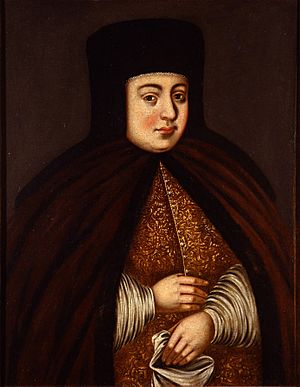Natalya Naryshkina facts for kids
Quick facts for kids Natalya Naryshkina |
|||||
|---|---|---|---|---|---|

Late 17th century portrait
|
|||||
| Tsaritsa consort of All Russia | |||||
| Tenure | 1 February 1671 – 29 January 1676 | ||||
| Born | 1 September 1651 Moscow, Tsardom of Russia |
||||
| Died | 4 February 1694 (aged 42) Moscow, Tsardom of Russia |
||||
| Burial | Ascension Convent Archangel Cathedral (1929) |
||||
| Spouse | |||||
| Issue |
|
||||
|
|||||
| House | Naryshkin | ||||
| Father | Kirill Poluektovich Naryshkin | ||||
| Mother | Anna Leontyevna Leontyeva | ||||
| Religion | Eastern Orthodox | ||||
Natalya Kirillovna Naryshkina (Russian: Ната́лья Кири́лловна Нары́шкина; September 1, 1651 – February 4, 1694) was a very important woman in Russian history. She was the Tsaritsa (empress) of Russia from 1671 to 1676. She became Tsaritsa by marrying Tsar Alexis I of Russia. Later, she also served as a regent for her son, Peter I of Russia, in 1682. A regent is someone who rules a country when the king or queen is too young or unable to rule themselves.
Contents
Life of Natalya Naryshkina
Natalya came from a noble Russian family. Her father was Kirill Poluektovich Naryshkin. She grew up in the home of a powerful noble named Artamon Matveyev. Matveyev was known for liking Western ideas and ways of life. Because of this, Natalya had a more open and Western-style upbringing than most Russian women of her time. This meant she had more freedom and learned different customs.
Becoming Tsaritsa
In March 1669, Tsar Alexis I's first wife, Tsarina Maria Miloslavskaya, passed away. She had many children, but only two sons were still alive, Feodor and Ivan. Both were not very healthy. Tsar Alexis wanted more healthy children to become heirs to the throne. So, he decided to marry again.
In early 1670, the Tsar held a "bride-show." This was a special event where eligible young women were presented to the Tsar so he could choose a new wife. Natalya was added to this group after the Tsar met her at Artamon Matveyev's home. Tsar Alexis was very impressed by Natalya's beauty. He chose her to be his bride right away.
Some people, especially the family of his first wife, tried to stop the marriage. They claimed that Matveyev had used magic to make Natalya seem more beautiful. These claims were investigated but found to be untrue. Natalya and Tsar Alexis were married on February 1, 1671.
Their marriage was a happy one. They spent a lot of time together in their palaces and villas around Moscow. Their first child, who would later become the famous Peter the Great, was born in May 1672. They also had two daughters, Natalya and Theodora.
At that time, it was common for the Tsar's wife to live a quiet life, mostly staying at home. But Natalya, with her Western upbringing, did not like these strict rules. She slowly gained more freedoms during her time as Tsaritsa. For example, she was allowed to ride in an open carriage and go to church without a veil covering her face. She also enjoyed dancing and was the first Russian woman to attend a theatre play.
In 1676, Tsar Alexis passed away, and Natalya became a widow. Her stepson, Feodor III, from the Tsar's first marriage, became the new Tsar. Feodor and his brother Ivan were kind to Natalya. They always called her "Mama."
Natalya as Regent
When Tsar Feodor III died in 1682, Natalya's son, who was only 10 years old, became the new Tsar. Because he was so young, Natalya became the regent. Her foster father, Artamon Matveyev, who had been sent away, was called back to be her advisor.
However, a serious event happened on May 15, 1682. There was a revolt by a group of soldiers called the Streltsy. During this revolt, two of Natalya's brothers and Artamon Matveyev were killed. Her biological father, Kyril Naryshkin, was forced to become a monk. After this, Feodor's older sister, Sophia Alekseyevna, took over as regent instead of Natalya.
Sophia's Rule as Regent
During Sophia's time as regent, Natalya lived a simpler life. Her son, Peter, was co-tsar with his half-brother Ivan, but Sophia held the real power. Natalya often received financial help from the Orthodox Church. She spent most of her time with Peter at Alexis's summer palace in Preobrazhenskoe, which was near Moscow.
Peter Takes Power
In August 1689, Peter finally took full control from Sophia. He and his half-brother Ivan continued to rule together as co-tsars. Natalya was once again an important figure at the court. Her brother, Lev Naryshkin, became the minister of foreign affairs and acted like a prime minister.
When the head of the Russian Orthodox Church, Patriarch Joachim, passed away in 1690, Peter wanted to choose a new leader. He preferred Marcellus, who had traveled abroad and spoke several languages. However, Natalya led a group of traditional nobles. They wanted a more conservative leader, Adrian, to head the church. Adrian was eventually chosen as the new Patriarch.
See also
 In Spanish: Natalia Naríshkina para niños
In Spanish: Natalia Naríshkina para niños

